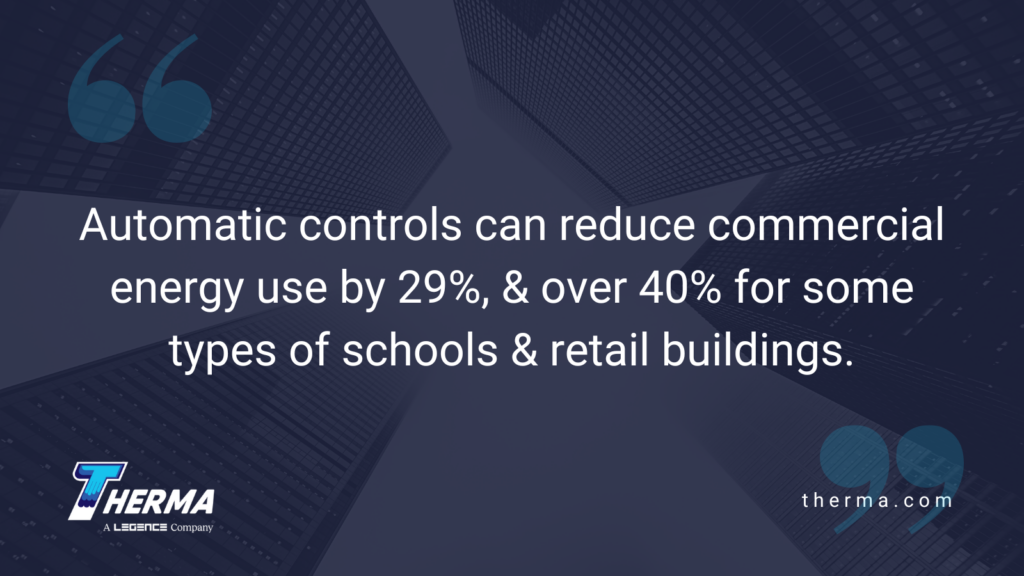by Patti Dees
Building automation goes hand in hand with energy efficiency. A building automation system (BAS) helps conserve energy by optimizing equipment and resources and improving maintenance and data for managing complex or large power-consuming systems.
The Case for BAS as a Tool for Energy Efficiency
According to a report from PNNL, automatic controls can reduce commercial energy use by 29%, and over 40% for some types of schools and retail buildings. But how, exactly, can building automation produce such striking results? Both energy efficiency plans and BAS focus on optimizing equipment, monitoring data, and managing maintenance and resources.
Two key building systems – HVAC and lighting – are the primary targets for efficiency and happen to be the two systems most likely to be controlled by a BAS. Alongside HVAC and lighting, fire and security systems can be monitored or controlled.
Having a building automation system installed is just the first step. Periodic maintenance of controllers and connected devices, and recommissioning the system and software ensure the data received by the BAS is reliable and actionable. Outdated controls and algorithms or poorly calibrated sensors lead to errors and wasted energy, not to mention increased labor and costs.
Optimization: A Balancing Act
Energy efficiency is not just about using less energy. It is also about using energy well. Energy consumed that does not actively produce desired results is wasted, usually as heat. For HVAC, optimizing equipment performance for that ideal chill is necessary for energy efficiency but also for cutting the heat load.
Smart technology can provide innovative ways to conserve energy. While some automation and data collection may be inherent in smart technology, coordination with other parts of the building’s systems is necessary. Building automation systems function as a link between devices so that they can be incorporated and used to their fullest extent with other controls and equipment.
Comfort may not be an obvious area for optimization. However, setpoints for both temperature and indoor air quality rely on balancing factors such as requirements for building occupation, energy use during peak demand, and actual use rather than assumed use of individual spaces. A building automation system provides monitoring and automation to ensure occupant comfort and health are not at cross ends to energy efficiency efforts.
Managing With Data: Better Than Rock, Paper, Scissors
For everything from quick decisions to long-term planning, data from building automation systems can be used in many ways. Centralized displays can show the status of critical equipment, fault alarms to notify staff of emergencies, diagnostic data, or reports from scheduled tests.
Large buildings and those with special requirements, such as data centers and hospitals, can become so extensive and complex that managing them without software of some kind is nearly impossible. A BAS offers the benefits of management software coupled with the ability to automate certain actions, further simplifying the burden on maintenance and other staff. Automation of louvers, fans, or valves in response to data from the field alleviates the need for guesswork. Testing can be automated during off-peak hours to avoid straining power reserves, with data or reports ready and waiting for review when needed.

A BAS promotes equipment efficiency by tracking statuses and results, so it is easier to identify where energy is wasted. For instance, if pumps or fans are running hotter or more frequently than normal, maintenance staff can adjust their schedules to investigate before equipment fails. The sooner the equipment is brought back to its target performance levels, the less energy is wasted.
Saving with a BAS: More Than Energy
Energy efficiency can save money and lead to smoother building operations. The most obvious saving is a lower utility bill. Where building automation systems shine is the long view. When equipment runs at optimal settings, and staff and resources are available for predictive or proactive maintenance, equipment lasts longer. Not only does this provide more time to develop a financial plan for eventual replacement, but data collection through the BAS gives an up-to-date picture, sometimes literally, of future design needs to continue or expand energy efficiency standards.
Energy efficiency efforts benefit from building automation. A building automation system is a great tool for monitoring use, optimizing equipment, and managing maintenance and resources. Therma professionals customize building automation systems to help clients achieve their conservation goals.
Patti draws on her background as a chemical engineer to share information with readers on technology, manufacturing, and construction.
Sources
Energy.gov – Report Delves Into the Impacts of Commercial Building Controls on Energy Savings
FacilitiesNet – How To Optimize a BAS To Improve Efficiency – Facilities Management Insights
Consulting-Specifying Engineer – Incorporate lighting controls with BAS to save energy | Consulting – Specifying Engineer
Health Facilities Management – Technological advances boost BAS performance | Health Facilities Management








